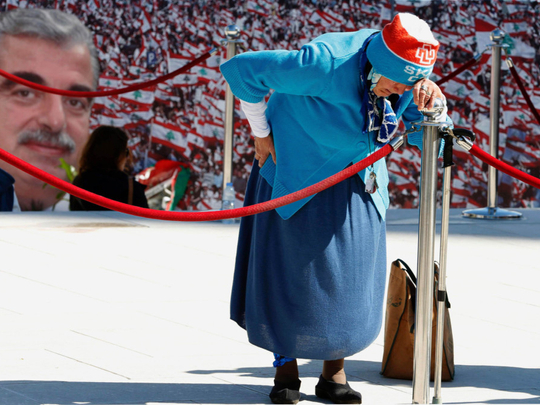
Beirut: Dozens of men, including Rafik Hariri, Basil Fleyhane, Samir Kassir, Georges Haoui, Gebran Tuéni, Pierre Gemayel, Antoine Ganem, Walid Eido, Wissam Eid, Wissam Al Hassan, Hashem Salman and Mohammad Chatah, have been murdered since 2005 so that Lebanon can continue to exist.
What happened on March 14, 2005 in Beirut was magical, not only because nearly 1.5 million citizens gathered in the city centre to voice opposition to the previous week’s (March 8) “Thank You Syria” demonstration, but also to announce the birth of the ‘Cedars Revolution’.
It was a rare cathartic moment that occurred under occupation. It took place a month after Hariri was killed, when Samir Geagea was still in prison, Michel Aoun in his Parisian exile, Amin Gemayel brooding in France and Walid Jumblatt under threat. Amazingly, demonstrators demanded that Damascus leave and their demands were realised a month later in April 2005.
That victory was not crowned with peace and stability, however, and while the Future Movement’s Sa’ad Hariri believed that the March 14, 2005 “independence intifada” ensured “freedom, sovereignty, and national dignity,” a solid portion of the Lebanese disagreed.
For a full decade, the ‘March 14’ coalition hammered its message, remained steadfast, and endured calamities galore. It fought the spirit of oppression and although millions perceived its core message — freedom — as a worthy goal, Hariri and his allies failed to reach a national agreement to reject tutelage and replace it with a functioning state.
On the contrary, ‘March 8’ forces led by Hezbollah, insisted on domestic parity and seldom shied away from their solidarity with the regime of Syrian President Bashar Al Assad, forcefully articulating the Iranian-sponsored mantra to what they believed was an American-Israeli collusion to subjugate nationalists.
In the aftermath of the post-2011 Arab uprisings that produced a bona fide civil war in Syria, Hezbollah reneged on the unanimously agreed June 2012 Baabda Declaration that distanced Lebanon from the war next door as Hezbollah deployed its forces to fight alongside Iranians supporting the Baath regime.
A decade hence, and despite what Sa’ad Hariri stated, that “the March 14 intifada created the basis for a national alliance that committed to the pledges of establishing a state and protecting the democratic system,” few are blinded by the rhetoric.
Miraculously Aoun returned from exile but switched sides to join the ‘March 8’ alliance and his former foe, Syria; Amin Gemayel lost his son Pierre to an assassination; Samir Geagea was out of jail but dodged the bullet and lives under permanent threat, and Walid Jumblatt, who flip-flopped a few times — he visited Bashar Al Assad on April 6, 2010 before he switched back, albeit unenthusiastically, and opted to lambast the Syrian regime after the latter’s massacres crossed the Rubicon — is still alive, though probably because he ended his anti-Hezbollah stand.
Hariri, who succeeded his father, lived outside of Lebanon for security reasons — though he travelled to Beirut twice during the past year.
In short, the alliance survived, even if its post-2005 stamina has been severely drained. Simply stated, few Lebanese looked up to the March 14 coalition as an effective political base, aware that every initiative was and is immediately defeated by ‘March 8’.
Even the group’s otherwise nationalist plank to support the Lebanese Armed Forces was and is rendered meaningless by the opposition, which prefers a stale triptych — “army, people, and [the] resistance” — although a majority of citizens reject the paradigm.
According to press reports, the ‘March 14’ coalition was poised to address its own shortcomings during the tenth anniversary commemoration of the Cedars Revolution on Saturday evening, when a new set of political principles was to be outlined to describe a fresh agenda.
Participants were expected to reveal the formation of a ‘March 14 National Council’ that would re-emphasise the alliance’s multi-sectarian nature, reject what its members perceived was rising extremism throughout the region, and reiterate previous positions, including a full application of the Ta’if Accords.
With nearly 300 members, this National Council was ostensibly slated to be governed by an elected executive, although the latter would only be a consultative body that will meet every two or three months to offer necessary recommendations. It remains unclear whether it will redefine Lebanese sovereignty that will protect the country’s constitution.












